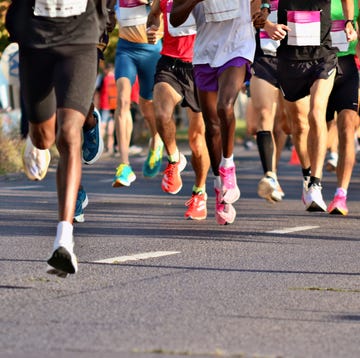Mile repeats are a quintessential interval workout that will help to build your physical and psychological fitness – their length forces you to adopt a race-like mentality. But when you change the pace or number of reps, you change the physiological effect, which makes them a key speedwork session for a range of race distances. You’ll want to build a session that matches your fitness, your performance goals and your ability to recover. But always bear in mind that mile repeats aren’t about bragging rights. They’re not the final goal. They’re a link in the chain, merely one training session among many, so don’t approach them with race intensity and risk overdoing it. You’ve got a great many miles to go in your running journey; these mile reps will simply help you travel that path a little faster.
1/ 5Health & Injuries
Reps at this pace rev your aerobic system to almost 100 per cent capacity, and it’s counterproductive to train at that effort level for longer than five to six minutes. In fact, runners slower than 18:30 for 5K should limit reps at 5K pace to shorter distances, such as 800m. These reps recruit slow-twitch, as well as intermediate- and fast-twitch muscle fibres, so you’ll increase capillary and mitochondrial density for them all. Do three to four reps, with recovery intervals that match the time of the repetition (half the duration for fitter runners).
2/ 10Health & Injuries
These are ideal for runners thinking about racing distances from 10K to the marathon. They produce less capillary and mitochondrial increase for faster muscle fibres than 5K repeats, but you’ll accrue greater improvement for both adaptations in slow-twitch fibres. You’ll increase blood volume (including red blood cells) and stroke volume, and improve your running economy. Miles at this pace are appropriate for runners who’ve raced a 10K in 45:00 or faster. Try four to six, with recovery intervals that are half the time of the repetition. If your 10K PB is slower than this, try this session with repeats of 1,200m or shorter.
3/ Cruise mile repeats
Cruise miles are useful for runners of all abilities and should be a part of all programmes, especially if you’re prepping for a marathon. They are done at a pace you feel you could maintain for an hour, allowing you to log a high volume of work at the effort level that’s most effective for increasing mitochondrial and capillary density in slow-twitch fibres. You’ll also build blood volume and improve running economy. Aim for 20-40 minutes of total volume, with recovery intervals that are half the time duration of the repetition (a quarter the duration for fitter runners).













